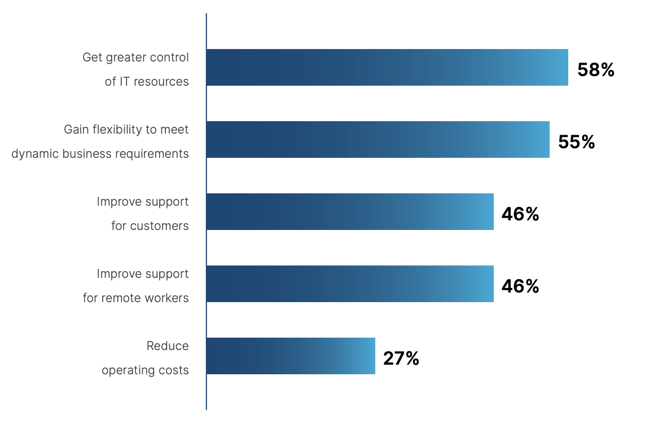Cloud computing in healthcare has exploded in recent years, with expected growth from 28.1 billion in 2020 to USD 64.7 billion by 2025. Most hospital CIOs are well aware of the cost saving benefits of cloud architectures and are looking beyond economics to target strategic business outcomes as drivers for moving their on-premise data centers to public clouds, like Amazon Web Services (AWS) or Microsoft Azure.
In a recent survey, respondents said their primary motives for adopting cloud architectures are to get greater control of their IT resources (58%), gain the flexibility to meet dynamic business requirements (55%), and improve support for customers and remote workers (46% respectively). By contrast, just 27% mentioned cutting costs as a driver (see figure 1).

Despite the known advantages, Gartner predicts that only 30% of hospital data centers will be based in the cloud by 2022. To help healthcare providers, payers, and business associates better understand the value of cloud-based infrastructure, we’ve outlined the top 8 benefits of cloud computing in healthcare.
- 1. Public cloud lets you pay by usage.
With on-premise infrastructure your capabilities are limited by your IT capacity. If your healthcare business is growing and you need to allocate more storage you must estimate how much will be needed, buy and procure new servers, then rack, stack and configure them – a process that can take several months. If you underestimate how much capacity you need you risk not being able to serve your customers or support business operations. If you overestimate, you’re left paying for capacity you’re not using. It’s a constant balancing act.
With cloud infrastructure you only pay for what you use and avoid the need to invest in capital equipment. You can stop guessing and align operating costs directly with demand. Then, in the event of an unforeseen circumstance, you’ll be able to meet the needs of your business and then scale capacity down when the event is over without adding extra baggage to your IT bill.
-
2. Public cloud makes it easy to keep up with computing technology.
In an on-premises model, it can be prohibitively costly to keep up with technology advances. Organizations typically replace on-premises servers every three to five years — an eternity in the fast-paced world of computing technology. When you own the technology, you are always playing catch-up.
Cloud service providers (CSPs) take the opposite approach. They adopt new technologies as they are introduced and quickly make them available to their customers as a competitive differentiator. Therefore, cloud users can access new technologies soon after they are introduced. For the CSP, keeping up with technology is part of their business model.
-
3. Public cloud is more secure than on-premises data centers.
When you own your data center and hardware, you are responsible for security from end to end. You’re responsible for physical premises security, from identity and access management on your servers to securing your software infrastructure while also securing your own applications and data.
In the public cloud, security is a shared responsibility between you and your CSP. The CSP secures the hardware and software that powers the cloud and, in most cases, the operating system too. You secure your applications and data that are stored in the cloud. This partitioning makes sense because each party is responsible for securing the part that they own and over which they have control.

Is the public cloud secure? Absolutely, and it’s not hard to see why. Cloud providers have the most experience with sophisticated attacks and can attract top security talent. Most importantly, your public cloud provider has a lot at stake — a single high-publicity data breach can cost the provider millions in lost revenue and damages, not to mention the significant reputation hit.
-
4. Public cloud scales better with essentially infinite resources.
That situation has a close parallel in the data center, as many telemedicine providers and healthcare organizations recently discovered to their dismay. When Covid-19 drove up demand for remote video visits exponentially in just days, companies with on-premises data centers didn’t have enough time to buy and install new equipment to meet the increased demand. Unfortunately, performance often worsened to the point where it degraded the patient and provider experiences and damaged the brand.
The Covid-19 experience was completely different for those providers who had their applications and data in the public cloud. These forward-looking organizations were able to scale in minutes by taking advantage of the provider’s vast reserves of computing power and storage facilities. As a result, these companies suffered little or no degradation in application performance and continued to deliver services as before. The takeaway is that the cloud scales much better than on-premises data centers.
-
5. Public cloud drives improvements in the patient experience.
More than ever before, patients and staff expect providers to take advantage of technology to streamline care processes and improve outcomes. Providers are working to improve the patient and staff experience with advanced technologies such as natural language interactions, 5G-based mobile apps, sophisticated analytics, and artificial intelligence and machine learning. Use cases range from reducing ER wait times, improving in-patient care, and providing at-home monitoring solutions.
Access to patient information is a key element in creating a positive patient experience. Patients have a right to view their healthcare information, but fulfilling that obligation can be a drain on hospitals and clinics. Self-service portals can greatly streamline the process while ensuring tight security for PHI.
-
6. Public cloud makes developers more productive.
Developers often need to create specialized environments to test their software code. In an on-premises data center, this process involves the IT department, which can take days or weeks. In the public cloud, developers can spin up a new environment in just minutes using the provider’s self-service portal, perform their tests, and easily tear down the environment. Public cloud not only speeds up the development process but also enables developers to try lots of alternatives quickly, leading to innovative products.
Major CSPs offer hundreds of cloud products that can aid software development. Developers can use these off-the-shelf modules instead of coding from scratch, shortening time to value and improving the quality of applications. This service is particularly helpful in adopting new technologies such as artificial intelligence, virtual reality, and robotics.
For example, suppose your organization wants to develop a self-service system to allow patients to access their EHR information without human intervention. Such an endeavor can seem daunting to developers who may not be familiar with technologies such as voice recognition, automated conversations, and semantics parsing. However, all of these functions are readily available from major cloud providers, which greatly simplifies the developer’s task.
Figure 2. Most technologically innovative U.S. hospitals by percentage of budget dedicated to IT2

-
7. Public cloud helps you unlock the insights hidden in your vast volumes of data.
Hospitals and other healthcare organizations have mountains of data on their patients, from EHRs and clinical records to billing and appointment histories. In principle, this information can be analyzed to build a comprehensive picture of each patient to improve care delivery and foster loyalty. However, before you can analyze the data, you have to find it. Patient information is often stored in different systems or silos, which makes it hard to work with in a coherent way.
Data lakes are one promising answer to this problem. Why lakes? Because a number of information streams flow into this single unified repository. Data lakes aren’t new, however, building them in the cloud has advantages such as unlimited storage, global access, reliable performance, and platform security. Data lakes automatically standard incoming data using machine learning techniques, which greatly facilitates analytics.
A data lake helps you combine data from the range of applications in a healthcare environment and open up a new world of insights into your organization. Patient falls can be researched by combining medical histories with building maintenance logs. Supply usage can be optimized using invoices and inventory reports. Patient populations can be studied and combined with organizational and environmental data to inform public health initiatives. The more you know, the more you can accomplish. The cloud can help educate you.
- 8. Public cloud takes away the hassle of managing IT infrastructure.
If your hospital hosts an on-premises data center, you’re in the information technology (IT) infrastructure business. And you’d better be good at it, because critical aspects of patient care and staff safety depend on the IT infrastructure operating smoothly around the clock, every day of the year. Managing IT infrastructure for healthcare organizations is strictly for experts — don’t try this at home.
Hospitals with on-premise data centers are forced to devote scarce resources such as capital investment, technical staff, and executive oversight to decidedly not healthcare-related initiatives such as upgrading servers and maintaining a disaster recovery site. For most healthcare executives, IT is neither their passion nor their training. They want to focus on issues such as improving clinical outcomes and delivering healthcare to populations — not IT infrastructure (see below).

Figure 3. Advantages of cloud over on-premises, survey results
Bottom Line
Your organization likely chose on-premise because there were no plausible alternatives at the time. Now you have options, so it makes sense to take a second look. Transitioning key parts of your operations from the data center to the cloud not only saves money and improves operations but it does more. It frees healthcare executives to focus on what they’re good at — delivering services in the most effective and efficient way possible.
What's more, these benefits accrue overtime as your enterprise reaches higher levels of cloud maturity. To learn more about how your organization can benefit from cloud computing in healthcare, download the free white paper, The Cloud Journey to Business Value in Healthcare.

